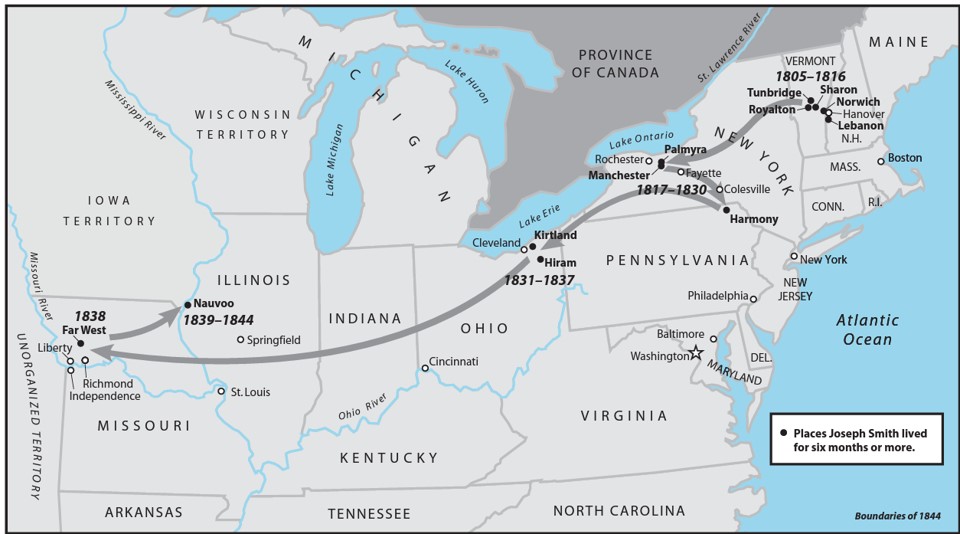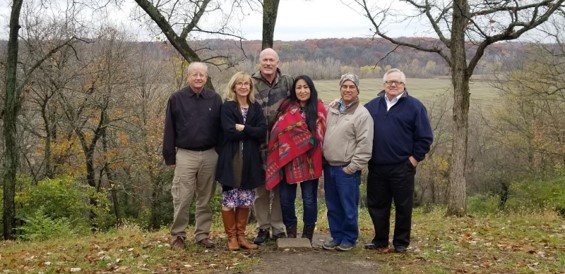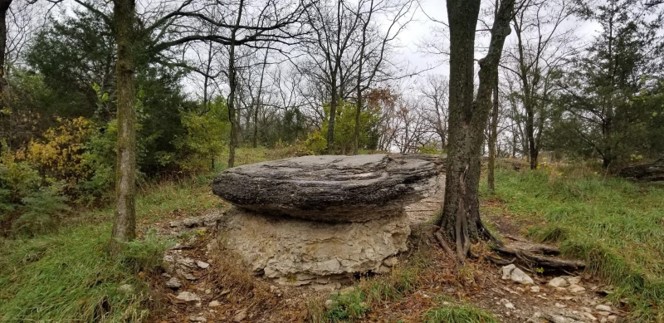Chronology of Events in Adam-ondi-Ahman

- Adam lived in Adam-ondi-Ahman after being cast out of the Garden of Eden
- Adam offered sacrifice as commanded of the Lord Adam was baptized, received the Holy Ghost and temple ordinances
- Three years before he died, Adam met with his righteous posterity and gave them the temple ordinances
- May 19, 1838, Joseph Smith revealed the location of Adam-ondi-Ahman
- June 25, 1838, saints living at Adam-ondi-Ahman were organized into a stake of Zion
- Latter-day Meeting at Adam-ondi-Ahman
Source: http://emp.byui.edu/satterfieldb/quotes/Adam-ondi-Ahman.html
Sacred Far West
Elder Dyer, whom President McKay subsequently ordained an apostle and later set apart as a counselor in the church presidency, offered some interesting after-thoughts on Far West:
“In connection with President McKay’s visit at Far West, it is to be noted that while there the President appeared somewhat overwhelmed. The place made a deep impression upon him; so much so that he referred to Far West a number of times in the ensuing days as a place of deep impression.
 “The feeling that President McKay had at Far West registered upon me once again, but now with greater impact. The events that transpired there are significant: (a) The Lord proclaimed Far West a holy and consecrated land unto him, declaring to Joseph Smith that the very ground he stood on there was holy. (b) The Prophet Joseph Smith contended with the devil face to face for some time, upon the occasion of the power of evil menacing one of his children in the Prophet’s home just west of the temple site. Lucifer declared that Joseph had no right to be there, that this was his place. Whereupon the Prophet rebuked Satan in the name of the Lord, and he departed and did not touch the child again. (c) The overwhelming feeling that President McKay had when he visited this sacred place.
“The feeling that President McKay had at Far West registered upon me once again, but now with greater impact. The events that transpired there are significant: (a) The Lord proclaimed Far West a holy and consecrated land unto him, declaring to Joseph Smith that the very ground he stood on there was holy. (b) The Prophet Joseph Smith contended with the devil face to face for some time, upon the occasion of the power of evil menacing one of his children in the Prophet’s home just west of the temple site. Lucifer declared that Joseph had no right to be there, that this was his place. Whereupon the Prophet rebuked Satan in the name of the Lord, and he departed and did not touch the child again. (c) The overwhelming feeling that President McKay had when he visited this sacred place.
“The Answer: I have often pondered the holy significance of Far West, and even more so since President McKay’s visit. The sacredness of Far West, Missouri, is no doubt due to the understanding that the Prophet Joseph Smith conveyed to the brethren, at these early times, that Adam-ondi-Ahman, the place to which Adam and Eve fled when cast out of the Garden of Eden, is where Adam erected an altar unto God, and offered sacrifices, and that Far West was the spot where Cain killed Abel.
“This information tends to explain why the Lord declared Far West to be a holy consecrated place; and no doubt explains why Satan claimed that place as his own, as it was here that he entered into a covenant with Cain, resulting in the death of Abel, the first of mortal existence [to die] upon this earth.
“It would appear that President McKay while there felt the spirit and significance of this holy place.” (The Life of Joseph Fielding Smith, p.340)
The Prophet and Party Reach Tower Hill.

“19 May 1838 • Saturday.—This morning we struck our tents and formed a line of march, crossing Grand River at the mouth of Honey Creek and Nelson’s Ferry. Grand River is a large, beautiful, deep and rapid stream, during the high waters of Spring, and will undoubtedly admit of navigation by steamboat and other water craft. At the mouth of Honey Creek is a good landing. We pursued our course up the river, mostly through timber, for about eighteen miles, when we arrived at Colonel Lyman Wight’s home. He lives at the foot of Tower Hill (a name I gave the place in consequence of the remains of an old Nephite altar or tower that stood there), where we camped for the Sabbath.” Josephsmithpapers.org History, 1838–1856, volume B-1 [1 September 1834–2 November 1838] page 797
“On 19 May 1838, a surveying party led by Joseph Smith, Prophet and first President of The Church of Jesus Christ of Latter-day Saints, arrived here to found a new city. One follower of the Prophet, Lyman Wight, had already acquired a home on the side of the hill southwest (to the right) of this point overlooking the valley. A half mile up the river Wight operated a ferry, and inland from that location the Prophet began laying out a city. He called it Adam-ondi-Ahman in tribute to Adam, the patriarch of the human race.

The Latter-day Saint settlement established two years earlier at Far West, approximately 35 miles to the southwest, had already doubled in size from its original plat of one-mile square. The Prophet desired to found other settlements after this pattern. His party spent ten days near Adam-ondi-Ahman and returned again later to stake out land on both sides of the river and eastward. In this vicinity he said there were “remains of a old Nephite altar or tower” (See History of the Church 3:35).” Historic Marker by the Church of Jesus Christ of Latter-day Saints at the Adam-ondi-Ahman Historic Site

“By following the roads as marked, visitors may see the area of Spring Hill, or Adam-ondi-Ahman. Also, there is an overlook of the western portion of the Valley of Adam-ondi-Ahman from a prominence called Tower Hill. Tower Hill is a name given by Joseph Smith because of the remains of an old Nephite altar (See History of the Church 3:35).” 2nd Historic Marker by the Church of Jesus Christ of Latter-day Saints at the Adam-ondi-Ahman Historic Site
“Daviess County was a beautiful place situated on Grand River. First rate land and plenty of good timber where we supposed there had been an ancient city of the Nephites, as the hewn stone were already there in piles also the mound or alter built by Father Adam, where he went to offer sacrifices when he was old. Leaning upon his staff, prophesying the most noted thing that should take place down to the latest generation therefore it was called Adam-ondi-Ahman.” History of Zera Pulsipher as written by himself. Autobiography (c.1803-1862
“While at the base of a large hill near Lyman Wight’s cabin, George W. Robinson recorded that they discovered “the remains of an old Nephitish Alter.” To commemorate the discovery, Joseph Smith called the place Tower Hill… So what did Robinson mean when he said they discovered the remains of a “Nephtish” structure? It is important to note that the early Latter-day Saints clearly believed that the native North American tribes were descendants of the earlier Nephite-Lamanite civilization. With this belief, Robinson probably used the word “Nephitish” to indicate that the structure or altar was built by, or originated with, the North American Indians. He may have also used “Nephitish” to mean that the altar was of ancient origin. Therefore, what Robinson was attempting to describe were the remains of what appeared to be a sacred altar structure erected by early Native Americans.” (Alexander L. Baugh, “Joseph Smith in Northern Missouri,” in Joseph Smith, the Prophet and Seer, ed. Richard Neitzel Holzapfel and Kent P. Jackson (Provo, UT: Religious Studies Center, Brigham Young University; Salt Lake City: Deseret Book, 2010), 291–346.)
“We pursued our course up the river, mostly through timber, for about eighteen miles, when we arrived at Colonel Lyman Wight’s home. He lives at the foot of Tower Hill (a name I gave the place in consequence of the remains of an old Nephite altar or tower that stood there), where we camped for the Sabbath.” (HC 3:34-35).” B.H. Roberts identifies Nephite tower remains in the following:
”A short distance south of spring Hill, or Adam-ondi-Ahman, was the home of Lyman Wight, at the foot, of “Tower Hill,” a name given to the place by Joseph Smith “in consequence of the remains of an old Nephite altar or tower,” he explains, “that stood there” (History of the Church, Period 1, vol. iii, 35). This old ruin has been quite generally accepted as marking the site of Adam-ondi-Ahman, an error, since “Tower Hill” is some half a mile east of that place; but because of the word “Adam” in the foregoing phrase, the altar or tower is supposed to have some association with the first patriarch of our race, hence it has been called “The grave of Adam” (History of Caldwell County, 118). (Also History of Daviess County, D. L. Kom). It will be seen by reference to the text above however, that Joseph Smith assigned the ruin to Nephite origin; and that it was but one of a number of such stone mounds or ruins in that vicinity: “We discovered some antiquities about one mile east of the camp [the camp was in the vicinity of Wight’s house], consisting of stone mounds, apparently erected in square piles, though somewhat decayed and obliterated by the weather (erosion) of many years. These mounds were probably erected to secrete treasures (History of the Church, Period 1, vol. iii, p. 37).” (B.H. Roberts, A Comprehensive History of The Church of Jesus Christ of Latter-day Saints, Century 1, Provo, Utah: Brigham Young University Press, Vol. 1, 1965, 421-22.) History of the Church Chapter 4 Pg. 34-40

“We pursued our course up the river, mostly through timber, for about eighteen miles, when we arrived at Colonel Lyman Wight’s home. He lives at the foot of Tower Hill (a name I gave the place in consequence of the remains of an old Nephite altar or tower that stood there), where we camped for the Sabbath… We discovered some antiquities about one mile west of the camp, consisting of stone mounds, apparently erected in square piles, though somewhat decayed and obliterated by the weather of many years. These mounds were probably erected by the aborigines of the land, to secrete treasures. We returned without game…” (Sacred experience in the Nauvoo Temple) “After the dancing had continued about an hour, several excellent songs were sung, in which several of the brethren and sisters joined… I called upon Sister Whitney who stood up and invoking the gift of tongues, sang a beautiful song of Zion in tongues. The interpretation was given by her husband, Bishop Whitney, and me, it related to our efforts to build this house to the privilege we now have of meeting in it, our departure shortly to the country of the Lamanites, their rejoicing when they hear the gospel and of the ingathering of Israel. I spoke in a foreign tongue; likewise, Brother Kimball. After a little conversation of a general nature I closed the exercises of the evening by prayer.” Manuscript History of the Church, 7:557–58.

“It appears that the saints in the banishing movements through the state of Missouri in order to lay the foundation of God’s great latter-day work yet to come, settled at the very places, within the consecrated area of Missouri, which were significant in the beginning of mankind upon the earth. First, in the “center place” at Independence, where once the Garden of Eden stood; at Far West, a most holy and consecrated area, and to Adam-ondi-Ahman, where Adam and his early posterity dwelt, where Cain killed his brother Abel and where sacrifices were offered to know the will of God.” The Refiner’s Fire” pp. 172-173, by Alvin R. Dyer. 1972 Deseret Book.
“Elder Dyer also has gathered reports of early brethren and residents of Daviess county which describe Adam-ondi-Ahman as the site of two ancient altars (neither of which is now to be seen) used by Adam. One of these, an “altar of prayer” he locates not far from the Lyman Wight house on Tower Hill. The other, an “altar of sacrifice,” is said to have been situated a mile or so away near the top of Spring Hill.” (BYU Studies, Vol. 13, No. 1, p.31) Robert J. Matthews (Professor, BYU)
“The Prophet Joseph called upon Brother Brigham, myself and others, saying, “Brethren, come, go along with me, and I will show you something,” He led us a short distance to a place where were the ruins of three altars built of stone, one above the other, and one standing a little back of the other, like unto the pulpits in the Kirtland Temple, representing the order of three grades of Priesthood; “There,” said Joseph, “is the place where Adam offered up sacrifice after he was cast out of the garden.” The altar stood at the highest point of the bluff. I went and examined the place several times while I remained there.” (Life of Heber C. Kimball, pp. 209-210)





